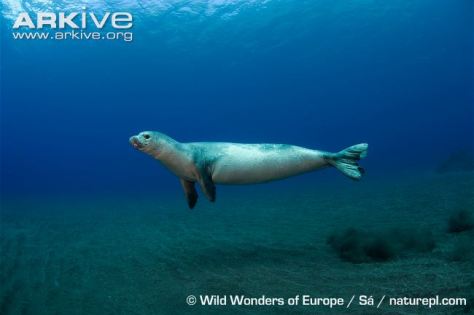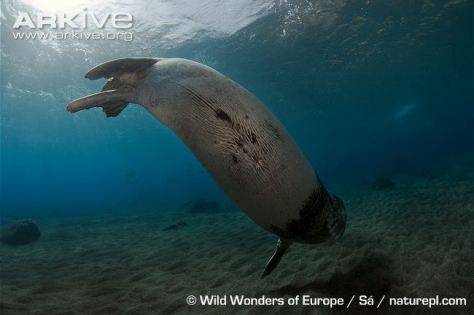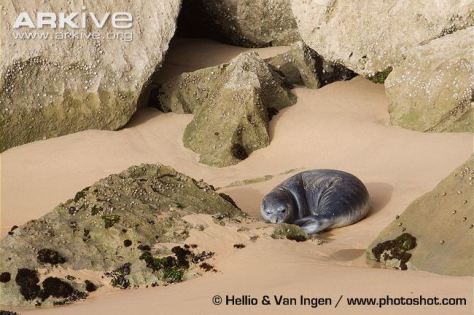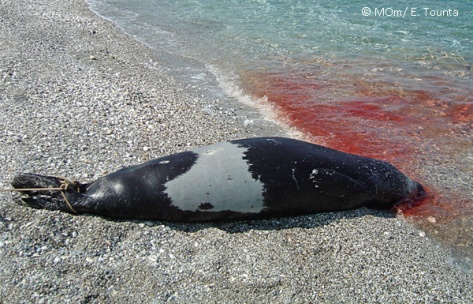In this post, we will do an approach to Mediterranean Monk Seal (Monachus monachus), a critically endangered species that, in fact, is the most endangered pinniped species in the world. Here, we are going to do a short historical review and we are going to talk about its natural history, its habitat and distribution, its threats and status and, finally, its conservation.
INTRODUCTION
Mediterranean Monk Seal (Monachus monachus) is one of the three species included in the genus Monachus (Monk Seals). The other two species are Hawaiian Monk Seal (Monachus schauinslandi), which is critically endangered, and Caribbean Monk Seal (Monachus tropicalis), which is extinct.

Mediterranean Monk Seals were hunted for fur, oil and meat since Prehistory. Romans were responsible of an important decline, but thanks to the empire’ fall the animals were able to recover. More recently, the two world wars, the industrial revolution, the explosion of tourism and industrial fishing have produced the reduction and disappearance of the species in some regions.
MEDITERRANEAN MONK SEAL’S NATURAL HISTORY
When they are born, their length is 94 cm and their weight is 15-20 kg. Until weaning (at about 16-17 weeks), growth takes place fast. The pups’ pelt is soft and downy and the coat is black to dark brown, with a white patch in the belly.
Adult individuals have a length of 2.4 m (from nose to tail) and weigh 250-300 kg. Males are only slightly bigger than females. Juveniles and adults have very short hair. While adult males are black with a white patch in the belly, adult females are brown and grey with a lighter belly colouration. In any case, they can present more patches on the throat (males) and back (females).


Males and females reach sexual maturity between 5 and 6 years. After a gestation lasting 9-11 month, one pup is born (generally in autumn).
They feed on fish and cephalopods.
HABITAT AND DISTRIBUTION
This species’ habitat is inaccessible caves with underwater entrances. The truth is that in ancient times, they inhabit open beaches of sand and rocks. Mediterranean monk seals can be found in warm temperate, subtropical and tropical waters of the Mediterranean Sea and the east Atlantic Ocean.


In ancient times, the species’ distribution was bigger than now. While now they just are present only in the northeast Mediterranean and in the northeast Atlantic, long ago they were present in all through the Mediterranean Sea, Black Sea, Atlantic coast of Africa and some Atlantic islands.

STATUS AND THREATS
With just 350-450 individuals (maybe 550), the Mediterranean Monk Seal is one of the world’s most endangered marine mammals and is the most endangered pinniped species and it is described as critically endangered by IUCN.

The main threats against the species are:
- Habitat degeneration and loss by development in the coast. The driving causes to this may be hunting, mass tourism, pleasure boats and diving. The result is that the caves occupied now are not adequate for their survival, so the recovery is only possible if they return to sandy beaches.
- Killing them on purpose by fisherman and fish farm operators because they find it a nuisance that destroys their nets and steals their fish. In Greece, deliberate killing accounts for 43% of the deaths of adult and juvenile animals.

- Accidental entanglement in fishing gear. It is unknown if this has an important impact nowadays, but in the recent past it was and, in fact, it has played a significant role in the elimination of the species from some parts.
- Decreased food availability due to overfishing. Malnourishment; susceptibility towards pathogens; affected growth, reproduction, juvenile survival and mortality rate and dispersion are the possible effects of this.
- Unusual events: disease (like morbillivirus), toxic algae, rockslides, cave collapses or oil spills.
- Pollution, maybe caused by organochlorine compounds used in pesticides.
- Inbreeding depression, that results in reduced fecundity and pup survival. This factor is not a significant threat in the short term, but it can be a future threat because this causes reduced fertility, increased infant mortality and a distorted sex ratio.
CONSERVATION
Since 1970s, conservation measures have been developed, but the improvements are hardly seen. Conservation measures include:
- Development of marine protected areas (MPA) in Madeira, Greece, Turkey and Cabo Blanco. In fact, what is necessary is a network of MPA.
- Orphaned and hurt animals are rescued.
- Educational programs.
- Scientific investigation to identify its habitat areas.
- International coordination of conservation activities.
On the other hand, ex situ conservation measures (like captive breeding and translocation) are not used because the species is so sensitive to human disturbance that it could be another threat.
REFERENCES
- Fauna Iberica: Foca monje
- IUCN Red List: Monachus monachus
- MarineBio: Mediterranean Monk Seals
- NOAA Fisheries, Office of Protected Resources: Mediterranean Monk Seal
- The Monachus Guardian (main source)
- Wildscreen Arkive: Mediterranean Monk Seal
If you enjoyed this article, please share it on social networks to spread it. The aim of the blog, after all, is to spread science and reach as many people as possible. Your comments are welcome.
This publication is under a Creative Commons License:


